The Brazilian merganser (Mergus octosetaceus) is one of the world’s rarest diving ducks, currently classified as critically endangered. It inhabits isolated stretches of fast-flowing rivers in Brazil, with an extremely small and fragmented population.
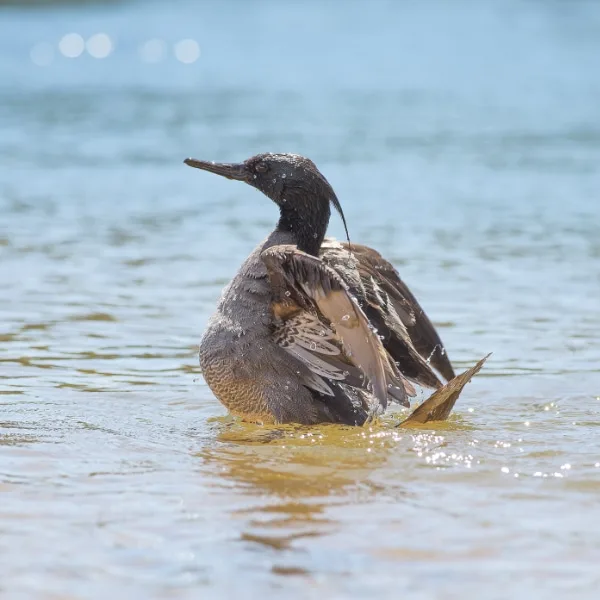
| Common name | Brazilian merganser |
| Scientific name | Mergus octosetaceus |
| Order | Anseriformes |
| Family | Anatidae |
| Genus | Mergus |
| Identification | Slender, dark plumage with a long crest; metallic green head and neck, serrated bill |
| Range | South-central Brazil, occasional reports from Argentina and Paraguay |
| Migration | Non-migratory |
| Habitat | Clean, fast-flowing rivers with rapids and gallery forests |
| Diet | Small fish, aquatic invertebrates |
| Conservation status | Critically endangered |
Discovery
The Brazilian merganser was first described by British naturalist Thomas Campbell Eyton in 1838, who provided a detailed account of its distinctive plumage and morphology. Belonging to the order Anseriformes and family Anatidae, it is classified within the Mergus genus, which includes fish-eating ducks characterized by their serrated bills, commonly referred to as “sawbills.”
In the mid-20th century, William H. Partridge conducted field observations of the species in Argentina between 1949 and 1954, offering additional insights into its distribution and behavior. Despite these efforts, historical records remain sparse, underscoring the species’ elusive nature and the inaccessibility of its remote riverine habitats.
Identification
The Brazilian merganser is a slender, medium-sized diving duck measuring approximately 49 to 56 cm (19.3–22 inches) in length, with a wingspan around 70 to 80 cm (27.6–31.5 inches). Males typically weigh about 800 g (28.2 oz), while females are slightly lighter, averaging 700 g (24.7 oz).
The species is easily recognized by its distinctive long, shaggy crest at the back of its head. Adults exhibit dark grayish-brown plumage on the back and wings, while the head and neck display a metallic dark green sheen, particularly visible under sunlight. The breast is pale gray with narrow, darker stripes, becoming paler toward the abdomen. A prominent white wing patch, or speculum, is noticeable in flight and while resting. The bill is long, thin, and serrated, aiding in gripping slippery fish, and the legs and feet are red with dusky webs. Sexual dimorphism is subtle, with males having slightly longer crests.
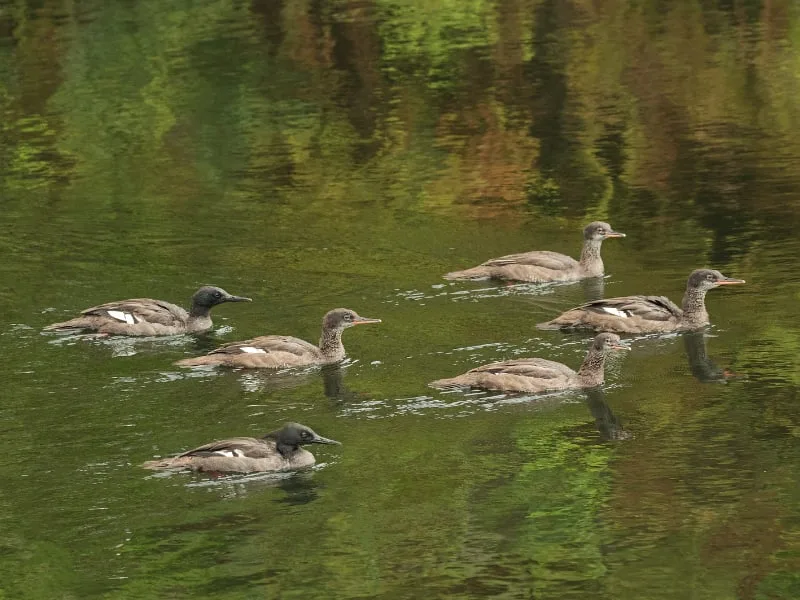
Juveniles are initially dark with noticeable white patches on their throats and breasts. As they mature, their plumage transitions to a more uniform grayish-brown, closely resembling adults but with a duller sheen and shorter crests. The white wing patch (speculum) becomes more visible as they age. This gradual shift in coloration and feather structure helps differentiate various stages of juvenile development.
Vocalization
The Brazilian merganser is generally a quiet species but produces distinct calls in specific situations. During flight, it emits a harsh “krack-krack” alarm call, while males are known to produce a barking, dog-like sound. Females vocalize with a rough “rrr-rrrr” call, particularly when alert or during interactions with mates. Additionally, a soft “rak-rak-rak” serves as a contact call between individuals, helping maintain group cohesion. Ducklings, on the other hand, emit a high-pitched “ik-ik-ik” call, especially when seeking attention or signaling distress.
Listen to the Brazilian merganser call:
Range and habitat
The Brazilian merganser is restricted to south-central Brazil, primarily around Serra da Canastra National Park in Minas Gerais, tributaries of the Rio São Francisco in Bahia, and limited populations in Goiás’ Emas and Chapada dos Veadeiros national parks. Historical records from Argentina and Paraguay suggest possible remnants in these countries, though recent confirmations are lacking.
The species inhabits clean, fast-flowing rivers with rapids and clear waters, surrounded by gallery forests and cerrado (tropical savanna) vegetation. It requires stretches of 5 to 12 kilometers of river for foraging and is highly sedentary, rarely leaving established territories. It prefers sparsely populated regions, avoiding human activity, though it may tolerate limited environmental disturbances if parts of its territory remain pristine.
Migration
The Brazilian merganser is non-migratory, remaining in its established river stretches year-round.
Behavior
The Brazilian merganser exhibits strong territorial behavior, with established monogamous pairs defending long stretches of river, typically ranging from 5 to 12 kilometers (3-7.5 miles). These lifelong pair bonds contribute to their coordinated territorial defense and foraging strategies. It is a shy species, often difficult to observe in the wild due to its preference for secluded, undisturbed habitats. In addition to its territoriality, the species demonstrates opportunistic feeding behavior, occasionally catching insects flying around its head while foraging. This adaptability complements its primary hunting method of diving for fish and macroinvertebrates in clear, fast-flowing waters.
Breeding
The Brazilian merganser is monogamous, with pairs often maintaining lifelong bonds. Nesting occurs in cavities of riverbanks, tree holes, or rock crevices, with entrances typically located 2 to 25 meters (up to 82 feet) above the water. Only the female incubates the clutch, which may contain up to eight eggs. The incubation period lasts around 34 days, during which the female leaves the nest twice daily to feed. The male remains nearby, vigilant in protecting the territory and assisting in rearing the young after hatching.
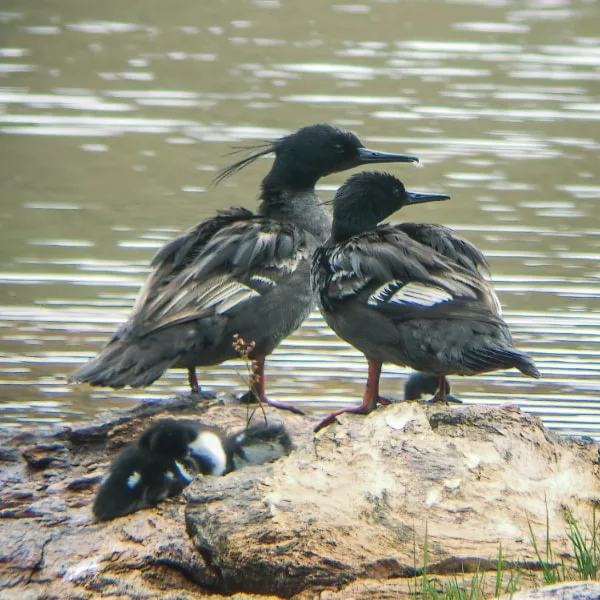
Ducklings leave the nest within a day of hatching, encouraged by the mother’s call. The family remains together for up to six months, with both parents feeding and protecting the young. Juveniles begin foraging independently around 10 days old and can perform short flights at approximately two months.
Diet
The Brazilian merganser, like other diving ducks, primarily feeds on small fish, such as lambaris and barrigudinho, which it captures during dives lasting between 15 to 30 seconds, with longer dives observed in deeper pools. Aquatic macroinvertebrates, including insect larvae, also contribute to their diet. The species often searches for prey by swimming with just its head submerged, scanning the riverbed for potential targets.
Stomach content analysis of individuals from Misiones, Argentina, revealed a diverse diet that includes lambaris, cichlids, catfish, virolito, larvae of Dobson flies, and possibly mollusks. This dietary flexibility suggests that while small fish form the bulk of their nutrition, they can adapt to available food sources within their habitat.
Threats and conservation
The Brazilian merganser is one of the world’s most threatened duck species, currently classified as critically endangered by the IUCN. Estimates suggest that fewer than 250 mature individuals remain in the wild, with some assessments indicating the population may be as low as 50 breeding adults. This extremely small and fragmented population highlights the urgent need for conservation measures to ensure the species’ survival.
The primary threats to the Brazilian merganser include habitat destruction and degradation caused by deforestation, agricultural expansion, mining activities, and the construction of hydroelectric dams. These activities contribute to river siltation, pollution, and the loss of the clear, fast-flowing rivers essential for the species’ survival.
Although diamond mining has ceased in some parts of its range, agricultural runoff and expanding farmland continue to pollute waterways. Additionally, tourism-related disturbances such as canoeing and rafting disrupt breeding and foraging behaviors within protected areas, including national parks. The species’ high sensitivity to environmental changes and its reliance on pristine river habitats make it particularly vulnerable to these pressures.
Conservation efforts
Conservation initiatives have focused on habitat protection and population monitoring, particularly in critical areas like Serra da Canastra National Park, which harbors the majority of the known population. Efforts also include riverbank protection and watershed conservation, especially in Bahia, to maintain water quality and reduce pollution. Captive breeding programs have been established to support population recovery and maintain genetic diversity, with recent genetic studies providing insights into inbreeding levels and guiding future reintroduction strategies.
There are proposals to expand protected areas, such as Chapada dos Veadeiros National Park, to encompass additional parts of the species’ range, particularly the Rio das Pedras population. Surveys in Paraguay and Argentina are recommended to verify historical populations and assess potential habitats for future conservation efforts.
Despite these efforts, the Brazilian Merganser’s population remains critically small and fragmented. Ongoing threats from habitat degradation, pollution, and human disturbance continue to pose significant challenges to the species’ survival. Continued habitat protection, pollution control, and public awareness campaigns are essential to prevent further decline and promote recovery.
Similar species
The Brazilian merganser (Mergus octosetaceus) has a distinctive appearance, but it shares some morphological traits with other members of the Mergus genus. While these species do not overlap in range, making misidentification in the wild unlikely, similarities in physical features could lead to confusion in captivity or zoological settings.
Red-breasted merganser (Mergus serrator)
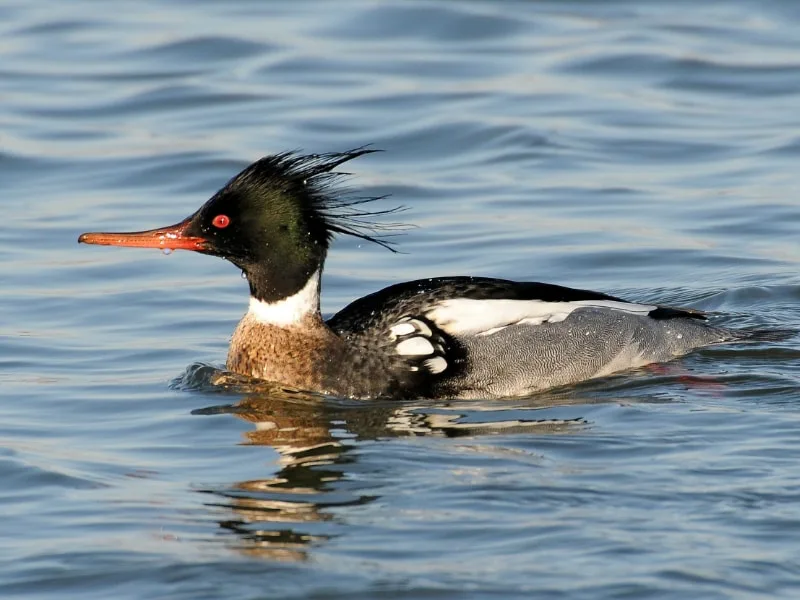
The red-breasted merganser is one of the most visually similar species, characterized by its slender body, long serrated bill, and shaggy crest. However, it differs in plumage, with males displaying a reddish-brown breast and a more pronounced contrast between body colors.
Scaly-sided merganser (Mergus squamatus)
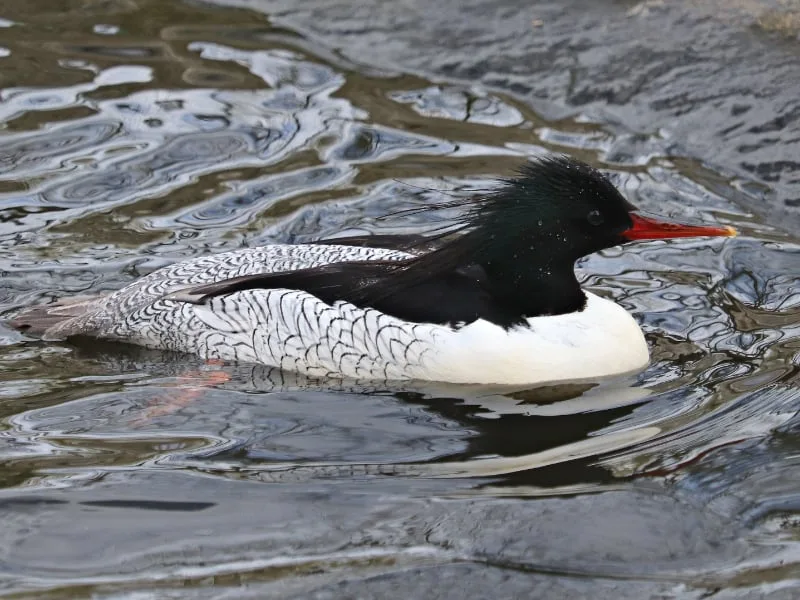
The scaly-sided merganser also bears resemblance to the Brazilian merganser, particularly in its crest and overall body shape. It is similarly dependent on clean, fast-flowing rivers, but features a distinctive scaly pattern on its flanks and a different coloration.
Both species are geographically restricted to different regions, with Mergus serrator inhabiting North America and Europe, and Mergus squamatus found in East Asia.
Further reading
The Brazilian merganser is not just one of the rarest birds in the world – it is a symbol of the fragile balance between species and their environments. Its story reflects the ongoing challenges faced by birds reliant on pristine habitats and highlights the critical role conservation efforts play in their survival. This article is the culmination of extensive research, field studies, and those rare, lucky moments when this elusive bird was observed in its natural habitat.
At Planet of Birds, we strive to bring attention to the world’s most threatened avian species, combining scientific research with firsthand observations. We hope this detailed account of the Brazilian merganser inspires a deeper appreciation for the delicate ecosystems these birds inhabit.
For those interested in learning more about critically endangered waterfowl and riverine habitats, we recommend exploring the following resources:
- (2024). Genetic Monitoring of the Captive Population of the Critically Endangered Brazilian Merganser (Mergus octosetaceus). MDPI.
- (2021). Remaining Suitable Areas for the Critically Endangered Brazilian Merganser (Mergus Octosetaceus; Aves, Anseriformes) are Threatened by Hydroelectric Power Plants. Perspectives in Ecology and Conservation.
- L. F. Silveira, W. D. Bartmann (2001). Natural History and Conservation of Brazilian Merganser Mergus Octosetaceus at Serra da Canastra National Park, Minas Gerais, Brazil. Cambridge University Press.
- P. de T. Z. Antas (1996). The Brazilian Merganser (Mergus octosetaceus), the Most Threathened Duck in South America.
